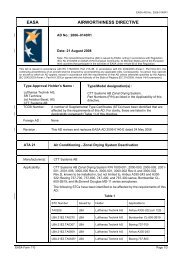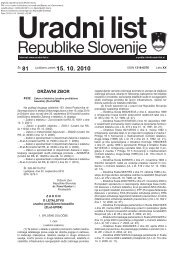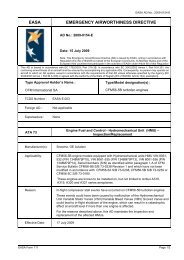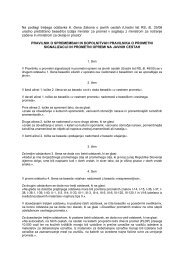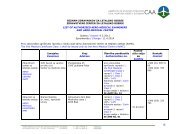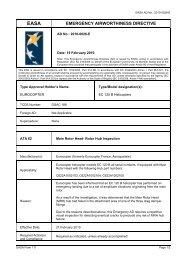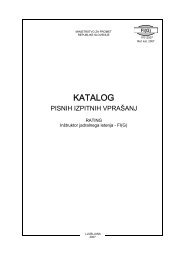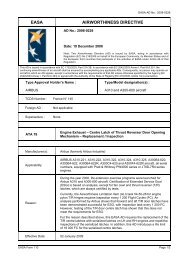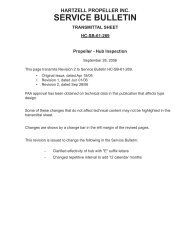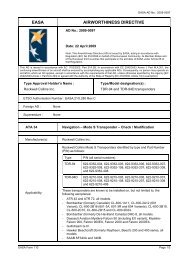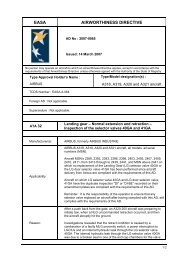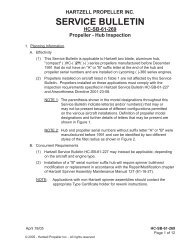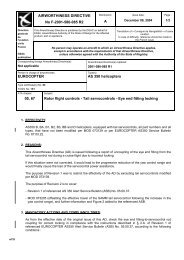FAA 2008-09-15
FAA 2008-09-15
FAA 2008-09-15
- No tags were found...
Create successful ePaper yourself
Turn your PDF publications into a flip-book with our unique Google optimized e-Paper software.
[Federal Register: May 2, <strong>2008</strong> (Volume 73, Number 86)][Rules and Regulations][Page 24<strong>15</strong>1-24<strong>15</strong>3]From the Federal Register Online via GPO Access [wais.access.gpo.gov][DOCID:fr02my08-7]––––––––––––––––––––––––––––––––––DEPARTMENT OF TRANSPORTATIONFederal Aviation Administration14 CFR Part 39[Docket No. <strong>FAA</strong>-2007-0046; Directorate Identifier 2007-NM-173-AD; Amendment 39-<strong>15</strong>496;AD <strong>2008</strong>-<strong>09</strong>-<strong>15</strong>]RIN 2120-AA64Airworthiness Directives; Boeing Model 737-100, -200, -200C, -300, -400, and -500 SeriesAirplanesAGENCY: Federal Aviation Administration (<strong>FAA</strong>), DOT.ACTION: Final rule.––––––––––––––––––––––––––––––––––SUMMARY: We are adopting a new airworthiness directive (AD) for all Boeing Model 737-100, -200, -200C, -300, -400, and -500 series airplanes. This AD requires repetitive inspections for anycracking of or damage to the left side and right side flight deck No. 2, No. 4, and No. 5 windows andcorrective actions if necessary. This AD results from reports of in-flight departure and separation ofthe flight deck windows. We are issuing this AD to detect and correct cracking in the vinyl interlayeror damage to the structural inner glass panes of the flight deck No. 2, No. 4, and No. 5 windows,which could result in loss of a window and rapid loss of cabin pressure. Loss of cabin pressure couldcause crew communication difficulties or crew incapacitation.DATES: This AD is effective June 6, <strong>2008</strong>.The Director of the Federal Register approved the incorporation by reference of certainpublications listed in this AD as of June 6, <strong>2008</strong>.ADDRESSES: For service information identified in this AD, contact Boeing Commercial Airplanes,P.O. Box 3707, Seattle, Washington 98124-2207.Examining the AD DocketYou may examine the AD docket on the Internet at http://www.regulations.gov; or in person atthe Docket Management Facility between 9 a.m. and 5 p.m., Monday through Friday, except Federalholidays. The AD docket contains this AD, the regulatory evaluation, any comments received, andother information. The address for the Docket Office (telephone 800-647-5527) is the Document1
Management Facility, U.S. Department of Transportation, Docket Operations, M-30, West BuildingGround Floor, Room W12-140, 1200 New Jersey Avenue, SE., Washington, DC 20590.FOR FURTHER INFORMATION CONTACT: Wayne Lockett, Aerospace Engineer, AirframeBranch, ANM-120S, <strong>FAA</strong>, Seattle Aircraft Certification Office, 1601 Lind Avenue, SW., Renton,Washington 98057-3356; telephone (425) 917-6447; fax (425) 917-6590.SUPPLEMENTARY INFORMATION:DiscussionWe issued a notice of proposed rulemaking (NPRM) to amend 14 CFR part 39 to include anairworthiness directive (AD) that would apply to all Boeing Model 737-100, -200, -200C, -300, -400,and -500 series airplanes. That NPRM was published in the Federal Register on October 17, 2007 (72FR 58766). That NPRM proposed to require repetitive inspections for any cracking of or damage tothe left side and right side flight deck No. 2, No. 4, and No. 5 windows and corrective actions ifnecessary.Changes Made to This ADWe have deleted paragraph (h)(4) of the NPRM and added a new paragraph (h) to this ADspecifying that installation of metallic window blanks at cockpit eyebrow windows No. 4 and No. 5in accordance with Supplemental Type Certificate (STC) ST01630SE terminates the initial andrepetitive inspections for the flight deck No. 4 and No. 5 windows required by paragraph (f) of thisAD. Incorporation of STC ST01630SE is considered a terminating action, not an alternative methodof compliance (AMOC), since an AMOC can only be issued after an AD has been issued. We havealso reidentified the AMOC paragraph of the NPRM as paragraph (i) in this AD.CommentsWe gave the public the opportunity to participate in developing this AD. We considered thecomments received from the three commenters.Support for the NPRMBoeing and Continental Airlines support the NPRM.Request to Expand ApplicabilityNorth Star Aerospace states that the affected window panels are also installed on Boeing Model707 and 727 airplanes and Model 737-600, -700, -800, and -900 series airplanes, and that it haswitnessed failure of the windows on these airplanes. North Star Aerospace believes the inspectionsshould be extended to include all airplanes equipped with window panels having part numbers (P/Ns)5-89355-( ), 5-89357-( ), and 5-89358-( ).We infer the commenter requests that we revise the applicability to add Model 707 and 727airplanes and Model 737-600, -700, -800, and -900 series airplanes. Since the affected windows areinterchangeable, we agree that the windows might be installed on all Model 707, 727, and 737airplanes. However, we do not agree to expand the applicability of this AD, since we have issuedseparate rulemaking actions to address the unsafe condition on Model 707 and 727 airplanes andModel 737-600, -700, -800, and -900 series airplanes. Please refer to Docket Nos. <strong>FAA</strong>-2007-0264,<strong>FAA</strong>-2007-0265, and <strong>FAA</strong>-2007-0263, respectively, at http://www.regulations.gov. No change tothis AD is necessary in this regard.2
Request To Revise the Compliance TimeContinental Airlines requests that we revise the compliance time for the initial inspection of theflight deck No. 2 window to within 36 months or 7,500 flight hours, whichever occurs first, after thewindow installation. Continental Airlines states that the NPRM, which proposes to require the initialinspection within 24 months after the effective date of this AD regardless of the age or flight time ofthe window, unnecessarily penalizes operators who proactively inspect and replace the No. 2 windowbefore the AD is issued. Continental Airlines also states that, according to the wording in the NPRM,a window replaced one day before the effective date of the AD would need to be re-inspected within24 months, but a window inspected and replaced one day after the effective date of the AD would notneed to be re-inspected until 36 months or 7,500 window flight hours, whichever is first.We do not agree to revise the compliance time for the initial inspection of the flight deck No. 2window. According to paragraph (e) of this AD, an operator is responsible for having the actionsrequired by this AD performed within the compliance times specified, unless the actions have alreadybeen done. If the initial inspection of the No. 2 window was done before the effective date of this ADin accordance with Boeing Alert Service Bulletin 737-56A1023, dated May 24, 2007, then the initialinspection does not need to be accomplished again; only the repetitive inspections would need to beaccomplished in accordance with the service bulletin at the applicable interval specified in the servicebulletin. If the initial and repetitive inspections of the No. 2 window are done before the effectivedate of this AD, but are not done in accordance with the service bulletin, then those inspections arenot acceptable for compliance with this AD unless an AMOC is issued for those prior inspections.Under the provisions of paragraph (i) of this AD, we will consider requests for approval of an AMOCif sufficient data are submitted to substantiate that prior inspections incorporate similar criteria towhat is provided for in the service bulletin. Therefore, no change to this AD is necessary in thisregard.Request for an AMOC for a Parts Manufacturer Approval (PMA) Equivalent PartContinental Airlines states that the <strong>FAA</strong> has approved a new, improved flight deck No. 2window designed by GKN Aerospace Transparency Systems, under PMA Holder No. PQ1250NM,Supplement 10, dated September 17, 2007. Continental Airlines states that the new, improved No. 2window was designed to prevent the premature failure of the window, and that new, improvedwindow addresses the unsafe condition of the NPRM. Continental Airlines, therefore, requests thatwe add a new AMOC paragraph to this AD, which would exempt the new, improved No. 2 windowfrom the required inspections.We do not agree to allow the PMA equivalent No. 2 window as an AMOC to the requiredinspections. Although the window has been approved as a PMA equivalent part, the commenter hasnot provided data showing that the PMA equivalent window is not susceptible to the same vinylinterlayer cracking. However, under the provisions of paragraph (i) of this AD, we will considerrequests for approval of an AMOC if sufficient data are submitted to substantiate that the designchange would provide an acceptable level of safety. No change to this AD is necessary in this regard.ConclusionWe reviewed the relevant data, considered the comments received, and determined that air safetyand the public interest require adopting the AD with the changes described previously. We alsodetermined that these changes will not increase the economic burden on any operator or increase thescope of the AD.3
Costs of ComplianceThere are about 2,685 airplanes of the affected design in the worldwide fleet. This AD affectsabout 799 airplanes of U.S. registry. The required inspections take about 2 work hours per airplane, atan average labor rate of $80 per work hour. Based on these figures, the estimated cost of the AD forU.S. operators is $127,840, or $160 per airplane, per inspection cycle.Authority for This RulemakingTitle 49 of the United States Code specifies the <strong>FAA</strong>'s authority to issue rules on aviation safety.Subtitle I, section 106, describes the authority of the <strong>FAA</strong> Administrator. ''Subtitle VII: AviationPrograms,'' describes in more detail the scope of the Agency's authority.We are issuing this rulemaking under the authority described in ''Subtitle VII, Part A, Subpart III,Section 44701: General requirements.'' Under that section, Congress charges the <strong>FAA</strong> with promotingsafe flight of civil aircraft in air commerce by prescribing regulations for practices, methods, andprocedures the Administrator finds necessary for safety in air commerce. This regulation is within thescope of that authority because it addresses an unsafe condition that is likely to exist or develop onproducts identified in this rulemaking action.Regulatory FindingsThis AD will not have federalism implications under Executive Order 13132. This AD will nothave a substantial direct effect on the States, on the relationship between the national government andthe States, or on the distribution of power and responsibilities among the various levels ofgovernment.For the reasons discussed above, I certify that this AD:(1) Is not a ''significant regulatory action'' under Executive Order 12866,(2) Is not a ''significant rule'' under DOT Regulatory Policies and Procedures (44 FR 11034,February 26, 1979), and(3) Will not have a significant economic impact, positive or negative, on a substantial number ofsmall entities under the criteria of the Regulatory Flexibility Act.You can find our regulatory evaluation and the estimated costs of compliance in the AD Docket.List of Subjects in 14 CFR Part 39Air transportation, Aircraft, Aviation safety, Incorporation by reference, Safety.Adoption of the AmendmentAccordingly, under the authority delegated to me by the Administrator, the <strong>FAA</strong> amends 14 CFR part39 as follows:PART 39–AIRWORTHINESS DIRECTIVES1. The authority citation for part 39 continues to read as follows:Authority: 49 U.S.C. 106(g), 40113, 44701.§ 39.13 [Amended]2. The <strong>FAA</strong> amends § 39.13 by adding the following new AD:4
<strong>FAA</strong>Aircraft Certification ServiceAIRWORTHINESS DIRECTIVEwww.faa.gov/aircraft/safety/alerts/www.gpoaccess.gov/fr/advanced.html<strong>2008</strong>-<strong>09</strong>-<strong>15</strong> Boeing: Amendment 39-<strong>15</strong>496. Docket No. <strong>FAA</strong>-2007-0046; Directorate Identifier2007-NM-173-AD.Effective Date(a) This airworthiness directive (AD) is effective June 6, <strong>2008</strong>.Affected ADs(b) None.Applicability(c) This AD applies to all Boeing Model 737-100, -200, -200C, -300, -400, and -500 seriesairplanes, certificated in any category.Unsafe Condition(d) This AD results from reports of in-flight departure and separation of flight deck windows.We are issuing this AD to detect and correct cracking in the vinyl interlayer or damage to thestructural inner glass panes of the flight deck No. 2, No. 4, and No. 5 windows, which could result inloss of a window and rapid loss of cabin pressure. Loss of cabin pressure could cause crewcommunication difficulties or crew incapacitation.Compliance(e) You are responsible for having the actions required by this AD performed within thecompliance times specified, unless the actions have already been done.Repetitive Inspections and Replacement(f) At the applicable times specified in Tables 1, 2, and 3 of paragraph 1.E. of Boeing AlertService Bulletin 737-56A1023, dated May 24, 2007, except as provided by paragraph (g) of this AD:Do the internal and external detailed inspections for any cracking of or damage to the left side andright side flight deck No. 2, No. 4, and No. 5 windows and do the applicable corrective actions beforefurther flight, by accomplishing all of the applicable actions specified in the AccomplishmentInstructions of the service bulletin. Repeat the inspections thereafter at the applicable intervalspecified in paragraph 1.E. of the service bulletin.Exception to Compliance Times(g) Where Tables 1, 2, and 3 of paragraph 1.E. of Boeing Alert Service Bulletin 737-56A1023,dated May 24, 2007, specify counting the compliance time from ''* * * the date on this servicebulletin,'' this AD requires counting the compliance time from the effective date of this AD.5
Optional Terminating Action(h) Installation of metallic window blanks at cockpit eyebrow windows No. 4 and No. 5 inaccordance with Supplemental Type Certificate ST01630SE terminates the initial and repetitiveinspections for the flight deck No. 4 and No. 5 windows required by paragraph (f) of this AD. Allother applicable actions required by paragraph (f) of this AD must be fully complied with.Alternative Methods of Compliance (AMOCs)(i)(1) The Manager, Seattle Aircraft Certification Office (ACO), <strong>FAA</strong>, has the authority toapprove AMOCs for this AD, if requested in accordance with the procedures found in 14 CFR 39.19.(2) To request a different method of compliance or a different compliance time for this AD,follow the procedures in 14 CFR 39.19. Before using any approved AMOC on any airplane to whichthe AMOC applies, notify your appropriate principal inspector (PI) in the <strong>FAA</strong> Flight StandardsDistrict Office (FSDO), or lacking a PI, your local FSDO.(3) An AMOC that provides an acceptable level of safety may be used for any repair required bythis AD, if it is approved by an Authorized Representative for the Boeing Commercial AirplanesDelegation Option Authorization Organization who has been authorized by the Manager, SeattleACO, to make those findings. For a repair method to be approved, the repair must meet thecertification basis of the airplane, and the approval must specifically refer to this AD.Material Incorporated by Reference(j) You must use Boeing Alert Service Bulletin 737-56A1023, dated May 24, 2007, to do theactions required by this AD, unless the AD specifies otherwise.(1) The Director of the Federal Register approved the incorporation by reference of this serviceinformation under 5 U.S.C. 552(a) and 1 CFR part 51.(2) For service information identified in this AD, contact Boeing Commercial Airplanes, P.O.Box 3707, Seattle, Washington 98124-2207.(3) You may review copies of the service information incorporated by reference at the <strong>FAA</strong>,Transport Airplane Directorate, 1601 Lind Avenue, SW., Renton, Washington; or at the NationalArchives and Records Administration (NARA). For information on the availability of this material atNARA, call 202-741-6030, or go to: http://www.archives.gov/federal_register/code_of_federal_regulations/ibr_locations.html.Issued in Renton, Washington, on April 18, <strong>2008</strong>.Ali Bahrami,Manager, Transport Airplane Directorate, Aircraft Certification Service.[FR Doc. E8-9312 Filed 5-1-08; 8:45 am]6



